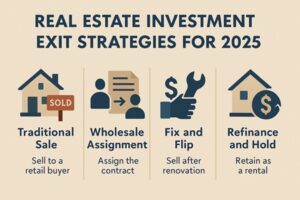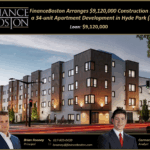
Real estate investment in Boston MA
This guide is Part 1 of a two-part breakdown designed to help you plan the final stage of your real estate investment with clarity and confidence. Because exit strategies often determine how much profit you keep, preparing early will significantly improve your long-term results. As you move through this first section, you will notice that each strategy is structured. It will help you maximize control, reduce uncertainty, and build a more predictable outcome.
Investors know that timing, financing, and preparation can change how much they walk away with at the end of a project. Therefore, thinking through your exit before purchasing a property is one of the most important habits of successful investors. With the right portfolio restructuring options, you protect your capital while positioning the asset for optimal performance.
Additionally, forward planning ensures that every major decision—from improvements to acquisition financing—is aligned with your end goal. When you treat your exit as part of your acquisition strategy, every step becomes more deliberate, and the results become easier to measure.
1. Traditional Sale to End Users: A High-Impact Real Estate Investment Exit
A traditional sale remains one of the most effective exit paths for a real estate investment. It targets retail buyers who often pay a premium for homes they fall in love with. Since end users shop emotionally, a well-presented property has the potential to generate stronger offers than an investor-focused sale. This makes the traditional route ideal for capturing maximum appreciation.
This strategy depends heavily on curb appeal and market trends. And, it becomes even more powerful when paired with professional selling investment property guidance. Retail buyers want turnkey homes, and when yours fits that criteria, you immediately attract more attention and more qualified offers.
Furthermore, a traditional sale is perfect for investors who want a full cash-out without ongoing obligations. Because many buyers in Boston MA look for move-in-ready properties, the demand can work in your favor and help you exit quickly at a top market price.
2. Wholesale Assignment: The Fastest Real Estate Investment Exit Strategy
Wholesaling remains a highly efficient tool for investors who want to exit a deal quickly and avoid renovation risk. In this method, you transfer your purchase contract to another buyer for a fee, allowing you to profit without owning or improving the property. Since this structure eliminates repairs and holding costs, it becomes attractive during uncertain market conditions.
When paired with effective investor cash-out strategies, wholesaling becomes a dependable way to generate revenue at scale. Because speed is the primary advantage, wholesalers rely heavily on strong buyer lists and targeted networking to keep deals moving efficiently.
Also, Boston MA continues to attract flippers and rental investors who actively search for off-market opportunities. That activity helps wholesalers convert contracts faster and more consistently, especially when motivated sellers are involved.
3. Fix and Flip Sale: Maximizing Value Through Smart Renovation

Real estate investment in Boston MA
The fix and flip model is one of the most recognized ways to profit from a real estate investment. By purchasing distressed properties, improving them, and selling at higher prices, investors can generate strong forced appreciation. This approach requires accurate budgeting and reliable contractors, but when executed well, it produces substantial returns.
Since your profit depends on strategic renovation choices, focused planning is essential. As you continue to refine your approach through property exit planning in Boston MA, you improve your ability to predict potential returns based on neighborhood demand and buyer preferences.
Moreover, flipping allows for faster capital recycling compared to long-term holds. Investors who want consistent liquidity often choose this route because they can turn one project into the next without waiting years for the property to appreciate naturally.
4. Refinance and Hold (BRRRR Strategy)
For investors seeking long-term growth, the BRRRR model—Buy, Rehab, Rent, Refinance, Repeat—remains a cornerstone strategy for expanding a real estate investment portfolio. After stabilizing the property with tenants, refinancing allows you to extract capital while keeping the asset in your name. FinanceBoston, Inc. can provide you with more details.
Because of this structure, the BRRRR method supports sustainable scaling. When paired with strong capital gains optimization, you continue building equity, collecting rental income, and accessing refinance opportunities as property values rise.
Furthermore, investors benefit from predictable cash flow in markets with strong rental demand. Since Boston MA consistently attracts renters, the long-term stability makes this strategy particularly appealing for those wanting recurring income and continued appreciation.
This concludes Part 1 of the full real estate investment exit strategy guide. Part 2 will be posted next and will cover four additional high-impact strategies. Be sure to return for the final installment so you can complete the full plan for your next investment.
If you want expert guidance to help you choose and execute the best exit strategy for your next project, contact FinanceBoston, Inc. today. Their team will help you protect your profits, strengthen your approach, and move forward with confidence in every real estate investment you make.
FinanceBoston, Inc.
33 Broad Street
Boston, MA 02109
617-861-2041
https://financeboston.com/




